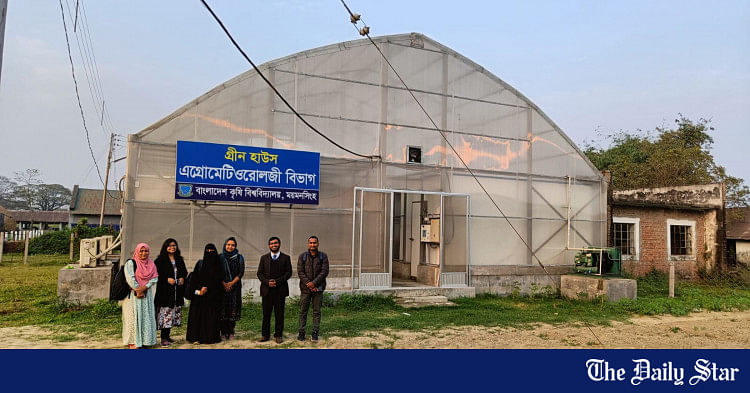Saif
Senior Member
- Joined
- Jan 24, 2024
- Messages
- 16,291
- Likes
- 8,084
- Nation

- Axis Group


Scientists eye climate-resilient crop varieties
A group of scientists of Bangladesh Agricultural University are working to develop new varieties of climate-resilient crops, including rice, maize and tomatoes, using a modern greenhouse, first of its kind at BAU.
Bangladesh Agricultural University
Scientists eye climate-resilient crop varieties
A group of scientists of Bangladesh Agricultural University are working to develop new varieties of climate-resilient crops, including rice, maize and tomatoes, using a modern greenhouse, first of its kind at BAU.
The scientists, led by Prof ABM Arif Hasan Khan of the Department of Agrometeorology, are collaborating with the Department of Agricultural Extension in a joint venture titled "Agrometeorological Information Systems Development Project" since last year.
A greenhouse is a transparent room, where various natural factors like heat, temperature, light, water, salinity and humidity are controlled and the effects of these factors on different crops are analysed and explained.
As a result, the production of any crop can be continued throughout the year in a greenhouse. The greenhouse at BAU has eight common rooms, low and temperature rooms for research, a central room from where the amount of water and fertilisers for different crops planted in different rooms can be regulated, controlled and monitored.

NRI Crop Technology -- a sensor-based equipment imported from Turkey -- delivers nutrients to each plant as needed. The research on crops' tolerance to adverse environmental conditions is being done by altering the characteristics of light including intensity and wavelength, temperature, water and salt tolerance of the seedlings planted externally through the device, the researchers said.
Prof Arif Khan said, "Agricultural productivity is largely dependent on several meteorological variables including temperature, solar radiation, hours of exposure to sunlight, lengths of winter and monsoon seasons. Since Bangladesh is a climate-vulnerable country, these climatic variables are gradually becoming extreme here. The highest and lowest temperatures are changing every year. In this situation, developing climate-resilient crop varieties has become important and scientists must engage to this end."
Prof Dr AKM Zakir Hossain, a member of the research team, said, "The new greenhouse will help develop different crop varieties that are tolerant to adverse weather conditions."
Prof Dr Aslam Ali, another team member, said, "Different crops have different requirements of nutrients for growth and development. The sensor-based operations deliver a balanced amount of nutrients to each plant. Right now, research is being conducted to develop eco-friendly varieties by changing the light, wavelength, temperature, water content, salinity level, etc externally through the machine."
Tanjim Ahmed, a postgraduate student engaged in the project, said, "Developing a heat-stress tolerant maize variety has been a successful outcome of the research. This variety can be cultivated in the comparatively warmer regions of the country."
Zaber Sabuj, another postgraduate student, said, "Work is ongoing to develop rice varieties that are tolerant to both salinity and high temperature. Once developed, these will help continue rice cultivation even in salinity prone 19 districts in the south."
Another researcher, Sirajum Monira, said it may become possible to produce winter tomato varieties even in summer through greenhouse method.
Postgraduate student Farzana Akter is focusing on finding out which rice varieties expel less methane in higher temperature regions.
The scientists said this modern greenhouse has opened the door for advanced agricultural research, and hoped that within five years, the outcomes of this research could reach the farmers' door.
As a result, the production of any crop can be continued throughout the year in a greenhouse. The greenhouse at BAU has eight common rooms, low and temperature rooms for research, a central room from where the amount of water and fertilisers for different crops planted in different rooms can be regulated, controlled and monitored.
NRI Crop Technology -- a sensor-based equipment imported from Turkey -- delivers nutrients to each plant as needed. The research on crops' tolerance to adverse environmental conditions is being done by altering the characteristics of light including intensity and wavelength, temperature, water and salt tolerance of the seedlings planted externally through the device, the researchers said.
Prof Arif Khan said, "Agricultural productivity is largely dependent on several meteorological variables including temperature, solar radiation, hours of exposure to sunlight, lengths of winter and monsoon seasons. Since Bangladesh is a climate-vulnerable country, these climatic variables are gradually becoming extreme here. The highest and lowest temperatures are changing every year. In this situation, developing climate-resilient crop varieties has become important and scientists must engage to this end."
Prof Dr AKM Zakir Hossain, a member of the research team, said, "The new greenhouse will help develop different crop varieties that are tolerant to adverse weather conditions."
Prof Dr Aslam Ali, another team member, said, "Different crops have different requirements of nutrients for growth and development. The sensor-based operations deliver a balanced amount of nutrients to each plant. Right now, research is being conducted to develop eco-friendly varieties by changing the light, wavelength, temperature, water content, salinity level, etc externally through the machine."
Tanjim Ahmed, a postgraduate student engaged in the project, said, "Developing a heat-stress tolerant maize variety has been a successful outcome of the research. This variety can be cultivated in the comparatively warmer regions of the country."
Zaber Sabuj, another postgraduate student, said, "Work is ongoing to develop rice varieties that are tolerant to both salinity and high temperature. Once developed, these will help continue rice cultivation even in salinity prone 19 districts in the south."
Another researcher, Sirajum Monira, said it may become possible to produce winter tomato varieties even in summer through greenhouse method.
Postgraduate student Farzana Akter is focusing on finding out which rice varieties expel less methane in higher temperature regions.
The scientists said this modern greenhouse has opened the door for advanced agricultural research, and hoped that within five years, the outcomes of this research could reach the farmers' door.



































